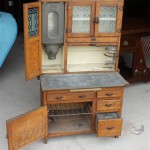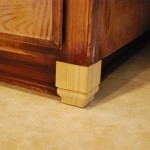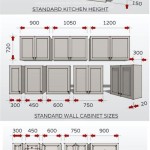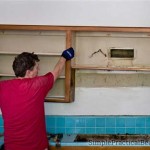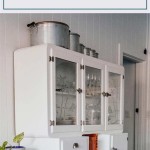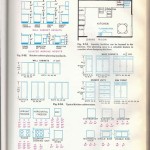Sanding Down Kitchen Cabinets: A Comprehensive Guide
Refinishing kitchen cabinets can significantly enhance the aesthetic appeal of a kitchen without the expense of a complete replacement. Sanding is an essential preparatory step in this process, ensuring proper adhesion of primer and paint. This article provides a comprehensive guide to sanding kitchen cabinets, covering the necessary tools, materials, techniques, and safety precautions.
Understanding the Importance of Sanding
Sanding serves multiple critical purposes in the cabinet refinishing process. First, it removes any existing finish, such as varnish, paint, or lacquer. The removal of the old finish is vital because new coatings may not adhere properly to a smooth, glossy surface. Second, sanding creates a slightly textured surface, often referred to as a "tooth," that provides an ideal anchor for primer and paint. This tooth allows the new finish to bond more effectively, resulting in a durable and long-lasting result. Third, sanding can address minor imperfections in the wood surface, such as scratches, dents, and blemishes, helping create a smoother and more uniform final appearance. Properly executed sanding is fundamental to achieving a professional-looking refinished cabinet.
It is important to note that sanding is not about aggressively removing material; it is about preparing the surface. Excessive sanding can damage the cabinet's veneer or solid wood components, leading to irreversible issues. Therefore, understanding the appropriate techniques and grit levels of sandpaper is crucial for successful cabinet refinishing.
Gathering the Necessary Tools and Materials
Before initiating the sanding process, acquiring the appropriate tools and materials is essential. The following list outlines the common items required:
*Sandpaper:
A variety of sandpaper grits are needed, typically ranging from 120-grit to 220-grit. Coarser grits (120-grit or similar) are used for removing the existing finish, while finer grits (180-grit to 220-grit) are used for creating a smooth surface for priming. It's also beneficial to have a higher grit sandpaper (320-grit or higher) for sanding between coats of primer and paint. *Sanding Block or Pad:
A sanding block or pad provides a flat, even surface for applying pressure while sanding. This helps to prevent uneven sanding and ensures a consistent finish. *Orbital Sander (Optional):
An orbital sander can significantly speed up the sanding process, particularly for large, flat surfaces. However, it's crucial to use the sander with caution and avoid applying excessive pressure, as this can lead to swirl marks. *Detail Sander (Optional):
A detail sander, often triangular in shape, is useful for sanding corners, edges, and other hard-to-reach areas. *Scraper (Optional):
A scraper can be helpful for removing thick or stubborn layers of existing finish before sanding. *Vacuum Cleaner or Shop Vac:
A vacuum cleaner or shop vac is essential for removing dust created during the sanding process. *Tack Cloth:
Tack cloths are used to remove any remaining dust particles from the surface after vacuuming. *Drop Cloths or Plastic Sheeting:
Drop cloths or plastic sheeting protect the surrounding areas from dust and debris. *Safety Glasses:
Safety glasses protect the eyes from dust and debris generated during sanding. *Dust Mask or Respirator:
A dust mask or respirator protects the lungs from inhaling fine dust particles. *Gloves:
Gloves protect the hands from dust, grime, and potential irritants. *Cleaning Supplies:
Consider using a degreaser or TSP (trisodium phosphate) solution to clean the cabinets prior to sanding to remove grease and grime, which can clog sandpaper.Ensuring you have all necessary materials before beginning will streamline the workflow and prevent delays.
Step-by-Step Sanding Procedure
The sanding procedure should be approached methodically to achieve optimal results. Follow these steps for sanding your kitchen cabinets:
Preparation:
Begin by removing all cabinet doors and drawers. Remove all hardware (knobs, pulls, hinges, etc.) from the doors, drawers, and cabinet frames. Thoroughly clean the cabinets with a degreaser or TSP solution to remove any grease, grime, or dirt. Allow the cabinets to dry completely before proceeding.Setup:
Lay down drop cloths or plastic sheeting to protect the surrounding floor and furniture. Ensure adequate ventilation in the work area.Initial Sanding (Coarse Grit):
Using a 120-grit or similar sandpaper, begin sanding the cabinet surfaces. Apply moderate pressure and sand in the direction of the wood grain. If using an orbital sander, avoid applying excessive pressure and keep the sander moving to prevent swirl marks. Focus on removing the existing finish. A scraper may be used beforehand for thick or peeling finishes.Second Sanding (Medium Grit):
Once the existing finish has been removed, switch to a 180-grit sandpaper. Sand the cabinets again, focusing on smoothing out any rough spots and creating a consistent surface. Pay particular attention to edges and corners, ensuring they are evenly sanded.Final Sanding (Fine Grit):
Finally, use a 220-grit sandpaper to further refine the surface. This step creates a smooth, even surface that is ideal for priming. Sand lightly, using minimal pressure.Sanding Details:
Use a detail sander or sanding block to sand corners, edges, and other hard-to-reach areas. Ensure that all surfaces are evenly sanded and free of any remaining finish.Dust Removal:
Thoroughly vacuum the cabinets and surrounding area to remove all dust particles. Use a tack cloth to wipe down the cabinets, ensuring that no dust remains.Inspection:
Carefully inspect the sanded surfaces for any imperfections. If necessary, touch up any areas that require additional sanding.
Following this systematic procedure is crucial for achieving a smooth, uniform surface that is properly prepared for priming and painting.
Sanding Different Cabinet Materials
The approach to sanding varies depending on the cabinet material. Understanding these differences is key to preventing damage and achieving the desired results.
Solid Wood Cabinets:
Solid wood cabinets are the most forgiving to sand. They can withstand more aggressive sanding if necessary. However, it's still important to avoid excessive sanding, as this can alter the shape of the cabinet components. Pay close attention to the wood grain and sand in the same direction to prevent scratches.Veneer Cabinets:
Veneer cabinets have a thin layer of wood adhered to a substrate, such as particleboard or MDF. Veneer is easily damaged by over-sanding. Use finer grits (180-grit or higher) and minimal pressure when sanding veneer cabinets. Be extremely cautious near edges and corners, where the veneer is most vulnerable to sanding through.Laminate Cabinets:
Laminate cabinets typically cannot be sanded in the same manner as wood cabinets. The laminate surface is a thin plastic layer that can be easily damaged by sanding. Refinishing the laminate cabinets often requires a specialized primer that promotes adhesion to the plastic surface. Consult a professional for recommendations on the best approach for refinishing laminate cabinets.MDF Cabinets:
MDF (Medium-Density Fiberboard) is a composite material that can be sanded, but it absorbs moisture easily. Avoid excessive sanding, which can expose the MDF core and make it susceptible to swelling when primed and painted. Seal the edges of MDF panels with a specialized primer to prevent moisture absorption.Identifying the cabinet material is essential for selecting the appropriate sanding techniques and materials.
Addressing Common Sanding Challenges
Several challenges can arise during the cabinet sanding process. Knowing how to address these issues can help maintain progress and prevent costly mistakes.
Clogged Sandpaper:
Sandpaper can become clogged with old finish or dust, reducing its effectiveness. To prevent clogging, regularly clean the sandpaper with a brush or vacuum. If the sandpaper becomes heavily clogged, replace it with a fresh sheet.Swirl Marks:
Swirl marks can occur when using an orbital sander. To minimize swirl marks, use a lower speed setting, apply minimal pressure, and keep the sander moving in a consistent pattern. Sand in the direction of the wood grain whenever possible.Uneven Sanding:
Uneven sanding can result in a surface that is not smooth or uniform. To avoid uneven sanding, use a sanding block or pad to distribute pressure evenly. Regularly check the surface for any uneven spots and address them as needed.Sanding Through Veneer:
Sanding through veneer can expose the substrate underneath, creating a visible blemish. To prevent sanding through veneer, use finer grits of sandpaper, apply minimal pressure, and be especially cautious near edges and corners.Dust Control:
Sanding generates a significant amount of dust, which can be a health hazard and can contaminate the work area. To control dust, use a vacuum cleaner or shop vac to remove dust as it is generated. Wear a dust mask or respirator to protect the lungs. Ensure adequate ventilation in the work area.Addressing these challenges proactively can prevent problems from escalating and ensure a successful cabinet refinishing project.
Safety Precautions
Sanding kitchen cabinets involves certain safety risks, primarily due to dust inhalation and potential eye injuries. Taking appropriate safety precautions is paramount to protect your health and well-being.
Eye Protection:
Always wear safety glasses to protect your eyes from dust and debris. Dust particles can cause irritation and potential injury to the eyes.Respiratory Protection:
Wear a dust mask or respirator to protect your lungs from inhaling fine dust particles. Prolonged exposure to dust can lead to respiratory problems.Hand Protection:
Wear gloves to protect your hands from dust, grime, and potential irritants. Gloves can also help to prevent splinters.Ventilation:
Ensure adequate ventilation in the work area. Open windows and doors to allow for fresh air circulation. Consider using a fan to help remove dust from the air.Dust Disposal:
Dispose of sanding dust properly. Avoid sweeping dust, as this can stir it up into the air. Instead, vacuum the dust and dispose of it in a sealed bag.Avoid Contact with Skin:
Some sanding dust can be irritating to the skin. Avoid prolonged contact with skin. Wash hands thoroughly after sanding.Prioritizing safety minimizes the risks associated with sanding and ensures a healthier and more comfortable working environment.
Post-Sanding Procedures
Once the sanding process is complete, several steps should be undertaken before priming and painting:
Thorough Cleaning:
Even after vacuuming and using a tack cloth, minute dust particles may remain. A final cleaning with a slightly damp cloth is recommended to remove remaining residue. Ensure the surface is completely dry before proceeding. Avoid using harsh chemicals that might leave a residue that interferes with primer adhesion.Priming:
Priming is a crucial step that provides a uniform surface for the paint to adhere to. Use a high-quality primer specifically designed for cabinets. Apply the primer evenly, following the manufacturer's instructions. Allow the primer to dry completely before proceeding to the next step.Light Sanding (Between Coats):
After the primer has dried, a light sanding with a very fine grit sandpaper (320-grit or higher) can help to smooth out any imperfections and improve paint adhesion. This step is optional but often results in a more professional-looking finish.Painting:
Apply the paint in thin, even coats, following the manufacturer's instructions. Allow each coat to dry completely before applying the next. Consider using a paint sprayer for a smoother, more professional finish.Reassembly:
Once the paint has dried completely, reassemble the cabinets, including installing the hardware and reattaching the doors and drawers. Take care to avoid scratching or damaging the freshly painted surfaces.Following these post-sanding procedures ensures the longevity and aesthetic appeal of the cabinet refinishing project.
Refinishing Kitchen Cabinets A Beautiful Mess

How To Paint Kitchen Cabinets A Step By Guide Confessions Of Serial Do It Yourselfer

Refinishing Kitchen Cabinets Modern Refacing Made Easy Wisewood

A Guide To Painting Kitchen Cabinets Norton Abrasives

How To Refinish Wood Cabinets The Easy Way Love Remodeled

A Guide To Painting Kitchen Cabinets Norton Abrasives

Cabinet Refinishing An 8 Step Guide For Pro Painters Ppc

Staining Your Wood Cabinets Darker Young House Love

How To Paint Kitchen Cabinets A Step By Guide Confessions Of Serial Do It Yourselfer

How To Make Rustic Kitchen Cabinets By Refinishing Them The Best Stain Color Amanda Katherine
Related Posts

